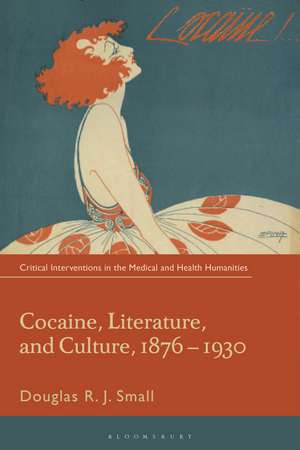Cocaine, Literature, and Culture, 1876-1930: Critical Interventions in the Medical and Health Humanities
Autor Douglas RJ. Smallen Limba Engleză Hardback – 24 ian 2024
Preț: 511.07 lei
Preț vechi: 731.59 lei
-30% Nou
Puncte Express: 767
Preț estimativ în valută:
97.79€ • 102.38$ • 80.92£
97.79€ • 102.38$ • 80.92£
Carte tipărită la comandă
Livrare economică 05-19 aprilie
Preluare comenzi: 021 569.72.76
Specificații
ISBN-13: 9781350400092
ISBN-10: 1350400092
Pagini: 264
Ilustrații: 11 bw illus
Dimensiuni: 156 x 234 mm
Greutate: 0.54 kg
Editura: Bloomsbury Publishing
Colecția Bloomsbury Academic
Seria Critical Interventions in the Medical and Health Humanities
Locul publicării:London, United Kingdom
ISBN-10: 1350400092
Pagini: 264
Ilustrații: 11 bw illus
Dimensiuni: 156 x 234 mm
Greutate: 0.54 kg
Editura: Bloomsbury Publishing
Colecția Bloomsbury Academic
Seria Critical Interventions in the Medical and Health Humanities
Locul publicării:London, United Kingdom
Caracteristici
Explores key issues around the contested nature of medical progress; the Victorian origins of sports doping; the history of anaesthesia and surgery; and the moral and ideological issues raised for medicine and medical practitioners by the use of cocaine as a local anaesthetic
Notă biografică
Douglas Small is a Lecturer in Nineteenth Century Literature at Edge Hill University, UK.
Cuprins
Introduction 1. Coca Leaves, Edward Weston, and the Victorian Origins of Sports Doping 2. Conquerors of Pain: Cocaine Anaesthesia and the Ideal Medical Man 3. Brutal Fashions: Cosmetic Surgery and Tattooing at the Fin-de-Siècle 4. Cocaine Bugs and the Horrors of Addiction 5. Sherlock Holmes and Cocaine in Canon and Comedy: Profession, Pleasure, and the Zany 6. White Powder, White Fears: Race, Sex, and Masculinity in the Jazz Age Conclusion Bibliography
Recenzii
Cocaine, Literature, and Culture presents a vital body of research and recovers lost and overlooked implications of the arrival of cocaine as both substance and metaphor. Drug history is suffused with ideological snares and retrospective impositions. Small's approach is not simply corrective but rather helps us to grasp the powerful effect of this singular substance on the Victorian cultural imagination.






